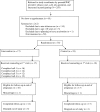Feasibility of a tobacco cessation intervention for pregnant Alaska Native women
- PMID: 20018946
- PMCID: PMC2816194
- DOI: 10.1093/ntr/ntp180
Feasibility of a tobacco cessation intervention for pregnant Alaska Native women
Abstract
Background: Among Alaska Native women residing in the Yukon-Kuskokwim (Y-K) Delta region of Western Alaska, about 79% smoke cigarettes or use smokeless tobacco during pregnancy. Treatment methods developed and evaluated among Alaska Native pregnant tobacco users do not exist. This pilot study used a randomized two-group design to assess the feasibility and acceptability of a targeted cessation intervention for Alaska Native pregnant women.
Methods: Recruitment occurred over an 8-month period. Enrolled participants were randomly assigned to the control group (n = 18; brief face-to-face counseling at the first visit and written materials) or to the intervention group (n = 17) consisting of face-to-face counseling at the first visit, four telephone calls, a video highlighting personal stories, and a cessation guide. Interview-based assessments were conducted at baseline and follow-up during pregnancy (>or=60 days postrandomization). Feasibility was determined by the recruitment and retention rates.
Results: The participation rate was very low with only 12% of eligible women (35/293) enrolled. Among enrolled participants, the study retention rates were high in both the intervention (71%) and control (94%) groups. The biochemically confirmed abstinence rates at follow-up were 0% and 6% for the intervention and control groups, respectively.
Discussion: The low enrollment rate suggests that the program was not feasible or acceptable. Alternative approaches are needed to improve the reach and efficacy of cessation interventions for Alaska Native women.
Figures
References
-
- Adams KE, Melvin CL, Raskind-Hood CL. Sociodemographic, insurance, and risk profiles of maternal smokers post the 1990s: How can we reach them? Nicotine & Tobacco Research. 2008;10:1121–1129. - PubMed
-
- Alaska Department of Health and Social Services. Health risks in Alaska among adults: Alaska Behavioral Risk Factor Survey (BRFSS) 2007 annual report. Anchorage, AK: Author; 2008.
-
- Alaska Humanities Forum. A survey on native perspectives on Alaska issues. 2003. Educational Bulletin: smoking cessation during pregnancy No 260.
-
- Bandura A. Health promotion by social cognitive means. Health Education and Behavior. 2004;31:143–164. - PubMed
-
- Benowitz NL, Ahijevych K, Jarvis M, Hall S, LeHouezec J, Hansson A, et al. Biochemical verification of tobacco use and cessation. Nicotine & Tobacco Research. 2002;4:149–159. - PubMed
Publication types
MeSH terms
Grants and funding
LinkOut - more resources
Full Text Sources
Medical


